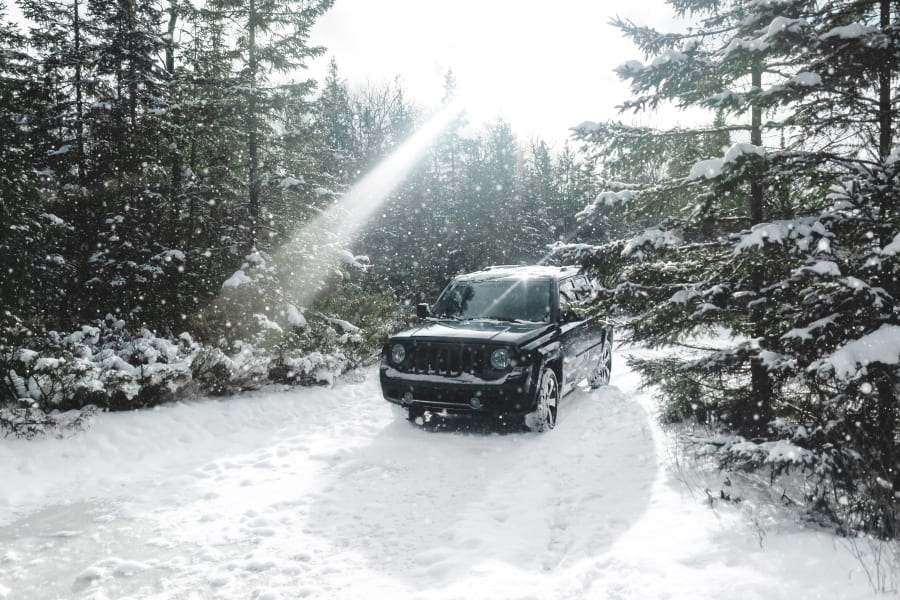
4×4 is a general term for a four-wheel-drive system on vehicles with two axles.
It is used specifically to indicate four-wheel-drive versions of Jeep cars. It means that the engine torque can be distributed to all four wheels at once.
How 4×4 works
Depending on the model and production year, Jeeps are equipped with the following types of 4×4 drivetrain:
- Part-time: normally, the torque is transferred to the rear axle. If necessary, the driver can connect the front axle. A dog clutch, located in the transfer case, is used for coupling both axles.
- Full-time: an inter-axle locking differential is used to connect both axles. The torque is constantly transferred to all four wheels at the same time.
- On-demand: by default, the front axle drives the vehicle. The system couples the rear axle only if the front wheels slip. A viscous or multi-plate friction clutch is used to do this. It couples the rear axle with the propeller shaft that receives the torque from the transfer case via a hypoid gear. It is constantly rotating. Some versions are equipped with an additional mechanical clutch, which allows the propeller shaft to be disengaged from the transfer case.
Types and features of 4×4
| Name | Drive type | Distinctive features | Jeep models equipped with this drive type |
| Command-Trac | Part-time | 4×4 can be used on slippery surfaces only. | Cherokee XJ, KJ, SJ; Comanche MJ; Wrangler YJ, TJ, JK, JL; Liberty KJ; Wagoneer SJ. |
| Command-Trac II | A central console switch is used for controlling the transfer case instead of a floor-mounted lever. | Liberty QC; Cherokee QC. | |
| Rock-Trac | There is no centre differential. The wheel differentials are equipped with a pneumatic or electronic locker. The lowest gear has a 4:1 ratio, which allows the vehicle to climb very steep hills. | Wrangler Rubicon TJ, JK, JL; Wrangler Unlimited Rubicon TJ, JK, JL; Gladiator Rubicon JT. | |
| Selec-Trac | Full-time with 2WD function | The open centre differential has an electronic locker. It can be also locked on demand, providing a fixed connection between the axles. A viscous clutch is also installed on some versions. |
Wagoneer XJ; Grand Wagoneer; Gladiator SJ; Comanche MJ; Grand Cherokee ZJ, WJ; Liberty KJ. |
| Selec-Trac II | AWD | There is a friction clutch which can be locked. | Liberty KK; Wrangler Sahara JL. |
| Quadra-Trac | Full-time | A limited-slip or viscous coupling differential is used for engaging both axles. It can be locked on demand. | Grand Cherokee ZJ; Wagoneer SJ. |
| Quadra-Trac II | It is controlled electronically by a limited-slip centre differential with a gerotor pump and can be locked on demand. The wheel differentials are open. | Commander XK. | |
| Quadra-Trac I | It has no low range gear. | Grand Cherokee WJ, WK, WK2; Commander XK. | |
| Quadra-Drive | The centre differential is a limited-slip one with a gerotor pump. | Grand Cherokee WJ | |
| Quadra-Drive II | Front and rear electronic locking differentials | Grand Cherokee WK, WK2; Commander XK. | |
| Freedom Drive I | AWD | An electromagnetic clutch is used to engage the rear axle if the front wheels are slipping. | Compass MK; Patriot MK |
| Freedom Drive II | There is a low range gear. | Patriot MK; Compass MK. | |
| Active Drive I | An electronically-controlled, multi-plate friction clutch is used for engaging the rear axle. An additional manual clutch makes it possible to fully disengage the propeller shaft. | Cherokee KL; Renegade. | |
| Active Drive II | There are two individual low range gears for each axle. | Cherokee KL; | |
| Active Drive Lock | Locking rear differential. | Renegade Trailhawk; Compass MP, M6 Trailhawk. |








Comment